Emergy Analysis and Ecological Spillover as Tools to Quantify Ecological Compensation in Xuchang City, Qingyi River Basin, China
Abstract
:1. Introduction
2. Materials and Methods
2.1. Study Area and Available Data
2.1.1. Study Area
2.1.2. Data Sources
2.2. Ecological Spillover as Eco-Compensation Proxy
2.3. Economic, Social, and Ecological Values of Ecosystem Services
2.3.1. Emergy-Based Evaluation of the Downstream Economic Ecosystem Services (EME)
2.3.2. Emergy-Based Evaluation of Downstream Social Ecosystem Services (EMS)
2.3.3. Emergy-Based Evaluation of Downstream Ecological Ecosystem Services (EMEE)
2.4. Emergy Analysis of the Local, Self-Supplied Ecosystem Services
2.4.1. Ecological Water-Footprint Demand (EFw)
2.4.2. Ecological Water-Footprint Supply (ESw)
2.5. Ecological Compensation
3. Results
3.1. Emergy and Monetary Value of Freshwater Ecosystem Services
3.2. Ecological Compensation Based on Ecological Spillover
4. Discussion
4.1. Freshwater Ecosystem Services
4.2. The Local, Self-Supplied Freshwater Ecosystem Services
4.3. Ecological Compensation of River Basin
5. Conclusions
Author Contributions
Funding
Institutional Review Board Statement
Informed Consent Statement
Data Availability Statement
Acknowledgments
Conflicts of Interest
References
- Parker, H.; Oates, N. How Do Healthy Rivers Benefit Society? A Review of Evidence; Working Paper 430; Overseas Development Institute and World Wildlife Fund: London, UK, 2016. [Google Scholar]
- Zheng, H.; Zhang, L. Chinese Practices of Ecological Compensation and Payments for Ecological and Environmental Services and Its Policies in River Basins; Working Paper 46923; The World Bank: Beijing, China, 2006. [Google Scholar]
- Sgroi, F.; Foderà, M.; Dana, L.; Mangiapane, G.; Tudisca, S.; Trapani, A.M.D.; Testa, R. Evaluation of payment for ecosystem services in Mediterranean forest: An empirical survey. Ecol. Eng. 2016, 90, 399–404. [Google Scholar] [CrossRef]
- Lv, C.M.; Ling, M.H.; Wu, Z.N.; Guo, X.; Cao, Q.Q. Quantitative assessment of ecological compensation for groundwater overexploitation based on emergy theory. Environ. Geochem. Health 2020, 42, 733–744. [Google Scholar] [CrossRef]
- Liu, J.Y.; Dou, S.Q.; Hmeimar, A.E.H. Cost-effectiveness analysis of different types of payments for ecosystem services: A case in the urban wetland ecosystem. J. Clean. Prod. 2020, 249, 119325. [Google Scholar]
- Mombo, F.; Lusambo, L.; Speelman, S.; Buysse, J.; Munishi, P.; van Huylenbroeck, G. Scope for introducing payments for ecosystem services as a strategy to reduce deforestation in the Kilombero wetlands catchment area. Forest. Policy Econ. 2014, 38, 81–89. [Google Scholar] [CrossRef]
- Wu, Z.N.; Guo, X.; Lv, C.M.; Wang, H.L.; Di, D.Y. Study on the quantification method of water pollution ecological compensation standard based on emergy theory. Ecol. Indic. 2018, 92, 189–194. [Google Scholar] [CrossRef]
- Zhang, M.; Zhou, J.; Zhou, R. Interval Multi-Attribute Decision of Watershed Ecological Compensation Schemes Based on Projection Pursuit Cluster. Water 2018, 10, 1280. [Google Scholar] [CrossRef] [Green Version]
- Bohlen, P.J.; Lynch, S.; Shabman, L.; Clark, M.; Shukla, S.; Swain, H. Paying for environmental services from agricultural lands: An example from the northern Everglades. Front. Ecol. Environ. 2009, 7, 46–55. [Google Scholar] [CrossRef]
- Liu, M.C.; Liu, W.W.; Yang, L.; Jiao, W.J.; He, S.Y.; Min, Q.W. A dynamic eco-compensation standard for Hani Rice Terraces System in southwest China. Ecosyst. Serv. 2019, 36, 100897. [Google Scholar] [CrossRef]
- Farley, J.; Costanza, R. Payments for ecosystem services: From local to global. Ecol. Econ. 2010, 69, 2060–2068. [Google Scholar] [CrossRef]
- Diswandi, D. A hybrid Coasean and Pigouvian approach to Payment for Ecosystem Services Program in West Lombok: Does it contribute to poverty alleviation? Ecosyst. Serv. 2017, 23, 138–145. [Google Scholar] [CrossRef]
- Jenkins, W.A.; Murray, B.C.; Kramer, R.A.; Faulkner, S.P. Valuing ecosystem services from wetlands restoration in the Mississippi Alluvial Valley. Ecol. Econ. 2010, 69, 1051–1061. [Google Scholar] [CrossRef]
- Atisa, G.; Bhat, M.G.; McClain, M.E. Economic Assessment of Best Management Practices in the Mara River Basin: Toward Implementing Payment for Watershed Services. Water Resour. Manag. 2014, 28, 1751. [Google Scholar] [CrossRef] [Green Version]
- Kaura, M.; Arias, M.E.; Benjamin, J.A.; Oeurng, C.; Cochrane, T.A. Benefits of forest conservation on riverine sediment and hydropower in the Tonle Sap Basin, Cambodia. Ecosyst. Serv. 2019, 39, 101003. [Google Scholar] [CrossRef]
- Sanchez, R.M.; Maldonado, J.H.; Wunder, S.; Almanza, C.B. Heterogeneous users and willingness to pay in an ongoing payment for watershed protection initiative in the Colombian Andes. Ecol. Econ. 2012, 75, 126–134. [Google Scholar] [CrossRef]
- Owuor, M.A.; Mulwa, R.; Otieno, P.; Icely, J.; Newton, A. Valuing mangrove biodiversity and ecosystem services: A deliberative choice experiment in Mida Creek, Kenya. Ecosyst. Serv. 2019, 40, 101040. [Google Scholar] [CrossRef]
- Gerner, N.V.; Nafo, I.; Winking, C.; Wencki, K.; Strehl, C.; Wortberg, T.; Niemann, A.; Anzaldua, G.; Lago, M.; Birk, S. Large-scale river restoration pays off: A case study of ecosystem service valuation for the Emscher restoration generation project. Ecosyst. Serv. 2018, 30, 327–338. [Google Scholar] [CrossRef]
- Pei, S.; Zhang, C.X.; Liu, C.L.; Liu, X.N.; Xie, G.D. Forest ecological compensation standard based on spatial flowing of water services in the upper reaches of Miyun Reservoir, China. Ecosyst. Serv. 2019, 39, 100983. [Google Scholar] [CrossRef]
- Zhong, S.Z.; Geng, Y.; Huang, B.B.; Zhu, Q.H.; Cui, X.W.; Wu, F. Quantitative assessment of eco-compensation standard from the perspective of ecosystem services: A case study of Erhai in China. J. Clean. Prod. 2020, 263, 121530. [Google Scholar] [CrossRef]
- Lai, M.; Wu, S.H.; Yin, Y.H.; Pan, T. Accounting for eco-compensation in the three-river headwaters region based on ecosystem service value. Acta Ecol. Sin. 2015, 35, 227–236. [Google Scholar]
- Fu, R.M.; Miao, X.L. A new financial transfer payment system in ecological function areas in China: Based on the spillover ecological value measured by the expansion emergy analysis. Econ. Resour. J. 2015, 50, 47–61. [Google Scholar]
- Wang, Y.Q.; Li, G.P. Study of watershed spillover ecological value compensation based on expansion emergy: A case of Weihe watershed upstream. China Popul. Resour. Environ. 2016, 26, 69–75. [Google Scholar]
- Hau, J.L.; Bakshi, B.R. Promise and problems of emergy analysis. Ecol. Model. 2004, 178, 215–225. [Google Scholar] [CrossRef]
- Henan Province Bureau of Statistics. The Statistical Yearbook of Henan Province (2011); China Statistics Press: Beijing, China, 2011. Available online: http://www.ha.stats.gov.cn/ (accessed on 5 July 2016).
- Henan Province Bureau of Statistics. The Statistical Yearbook of Henan Province (2012); China Statistics Press: Beijing, China, 2012. Available online: http://www.ha.stats.gov.cn/ (accessed on 5 July 2016).
- Henan Province Bureau of Statistics. The Statistical Yearbook of Henan Province (2013); China Statistics Press: Beijing, China, 2013. Available online: http://www.ha.stats.gov.cn/ (accessed on 5 July 2016).
- Henan Province Bureau of Statistics. The Statistical Yearbook of Henan Province (2014); China Statistics Press: Beijing, China, 2014. Available online: http://www.ha.stats.gov.cn/ (accessed on 5 July 2016).
- Henan Province Bureau of Statistics. The Statistical Yearbook of Henan Province (2015); China Statistics Press: Beijing, China, 2015. Available online: http://www.ha.stats.gov.cn/ (accessed on 5 July 2016).
- Xuchang Bureau of Statistics. The Statistical Yearbook of Xuchanng City (2015); Xuchang Statistics Bureau Publications: Xuchang, China, 2015.
- Xuchang Water Conservancy Bureau. The Water Resources Bulletin of Xuchang City (2010); Xuchang Water Conservancy Bureau Publications: Xuchang, China, 2010.
- Xuchang Water Conservancy Bureau. The Water Resources Bulletin of Xuchang City (2011); Xuchang Water Conservancy Bureau Publications: Xuchang, China, 2011.
- Xuchang Water Conservancy Bureau. The Water Resources Bulletin of Xuchang City (2012); Xuchang Water Conservancy Bureau Publications: Xuchang, China, 2012.
- Xuchang Water Conservancy Bureau. The Water Resources Bulletin of Xuchang City (2013); Xuchang Water Conservancy Bureau Publications: Xuchang, China, 2013.
- Xuchang Water Conservancy Bureau. The Water Resources Bulletin of Xuchang City (2014); Xuchang Water Conservancy Bureau Publications: Xuchang, China, 2014.
- Odum, H.T. Environment Accounting: Emergy and Environment Decision Making; John Wiley & Sons: New York, NY, USA, 1996. [Google Scholar]
- Lan, S.F.; Qin, P.; Lu, H.F. Emergy Analysis of Ecological-Economic System; Chemical Industry Press: Beijing, China, 2002. [Google Scholar]
- Price Division of National Development and Reform Commission. Compilation of Cost and Income Data of Agricultural Products in China (2011); Chinese Statistics Press: Beijing, China, 2011.
- Price Division of National Development and Reform Commission. Compilation of Cost and Income Data of Agricultural Products in China (2012); Chinese Statistics Press: Beijing, China, 2012.
- Price Division of National Development and Reform Commission. Compilation of Cost and Income Data of Agricultural Products in China (2013); Chinese Statistics Press: Beijing, China, 2013.
- Price Division of National Development and Reform Commission. Compilation of Cost and Income Data of Agricultural Products in China (2014); Chinese Statistics Press: Beijing, China, 2014.
- Price Division of National Development and Reform Commission. Compilation of Cost and Income Data of Agricultural Products in China (2015); Chinese Statistics Press: Beijing, China, 2015.
- Brown, M.T.; Ulgiati, S. Energy quality, emergy, and transformity: H.T. Odum’s contributions to quantifying and understanding systems. Ecol. Model. 2004, 178, 201–213. [Google Scholar] [CrossRef]
- Herendeen, R.A. Energy analysis and EMERGY analysis—A comparison. Ecol. Model. 2004, 178, 227–237. [Google Scholar] [CrossRef]
- Fonseca, A.M.P.; Marques, C.A.F.; Pinto-Correia, T.; Campbell, D.E. Emergy analysis of a silvo-pastoral system, a case study in southern Portugal. Agroforest. Syst. 2016, 90, 137–157. [Google Scholar] [CrossRef]
- Yang, Q.; Liu, G.Y.; Hao, Y.; Zhang, L.X.; Giannetti, B.F.; Wang, J.J.; Casazza, M. Donor-side evaluation of coastal and marine ecosystem services. Water Res. 2019, 166, 115028. [Google Scholar] [CrossRef]
- Dan, C. Keeping the Books for the Environment and Society: The Unification of Emergy and Financial Accounting Methods. J. Environ. Account. Manag. 2013, 1, 25–41. [Google Scholar]
- Lv, C.M.; Zhang, W.Y.; Ling, M.H.; Li, H.Q.; Zhang, G.J. Quantitative analysis of eco-economic benefits of reclaimed water for controlling urban dust. Environ. Geochem. Health 2020, 42, 2963–2973. [Google Scholar] [CrossRef]
- Lv, C.M.; Wu, Z.N. Emergy analysis of regional water ecological-economic system. Ecol. Eng. 2009, 35, 703–710. [Google Scholar] [CrossRef]
- Di, D.Y.; Wu, Z.N.; Guo, X.; Lv, C.M.; Wang, H.L. Value Stream Analysis and Emergy Evaluation of the Water Resource Eco-Economic System in the Yellow River Basin. Water 2019, 11, 710. [Google Scholar] [CrossRef] [Green Version]
- Xie, G.D.; Zhang, C.X.; Zhang, L.M.; Chen, W.H.; Li, S.M. Improvement of the evaluation method for ecosystem service value based on per unit area. J. Nat. Resour. 2015, 30, 1243–1254. [Google Scholar]
- Asah, S.T.; Blahna, D.J. Involving Stakeholders’ Knowledge in Co-designing Social Valuations of Biodiversity and Ecosystem Services: Implications for Decision-Making. Ecosystems 2020, 23, 324–337. [Google Scholar] [CrossRef]
- Chai, J.X. Study on Plant Community Allocation and Functional Improvement in the Riparian Zone of the Qingyi River Basin. Master’s Thesis, Zhengzhou University, Zhengzhou, China, 2019. [Google Scholar]
- Chen, H.M. Study on Dynamic Water Environmental Capacity of Qingyi River Basin (Xuchang). Master’s Thesis, Zhengzhou University, Zhengzhou, China, 2016. [Google Scholar]
- Zhao, Y.B.; Yang, M.Z.; Ni, H.G. An emergy-GIS method of selecting areas for sponge-like urban reconstruction. J. Hydrol. 2018, 564, 640–650. [Google Scholar] [CrossRef]
- Carey, R.O.; Migliaccio, K.W.; Brown, M.T. Nutrient discharges to Biscayne Bay, Florida: Trends, loads, and a pollutant index. Sci. Total Environ. 2011, 409, 530–539. [Google Scholar] [CrossRef]
- Qingyi River Project Team. The Status Water Resources Evaluation Report of Qingyi River Basin of Xuchang; Zhengzhou University: Zhengzhou, China, 2018; Unpublished work. [Google Scholar]
- Su, Y.; Gao, W.J.; Guan, D.J.; Su, W.C. Dynamic assessment and forecast of urban water ecological footprint based on exponential smoothing analysis. J. Clean. Prod. 2018, 195, 354–364. [Google Scholar] [CrossRef]
- Huang, L.N.; Zhang, W.X.; Jiang, C.L.; Fan, X.Q. Ecological footprint method in water resources assessment. Acta Ecol. Sin. 2008, 28, 1279–1286. [Google Scholar]
- Xiong, N.N.; Xie, S.Y. A study of the spatio-temporal evolution of water resource ecological footprint and ecological carrying capacity of Chengdu. J. Southwest Univ. (Nat. Sci. Ed.) 2019, 41, 118–126. [Google Scholar]
- Aguilar, F.X.; Obeng, E.A.; Cai, Z. Water quality improvements elicit consistent willingness-to-pay for the enhancement of forested watershed ecosystem services. Ecosyst. Serv. 2018, 30, 158–171. [Google Scholar] [CrossRef]
- Bangash, R.F.; Passuello, A.; Sanchez-Canales, M.; Terrado, M.; López, A.; Elorza, J.F.; Ziv, G.; Acuña, V.; Schuhmacher, M. Ecosystem services in Mediterranean river basin: Climate change impact on water provisioning and erosion control. Sci. Total Environ. 2013, 458–460, 246–255. [Google Scholar] [CrossRef]
- Saraswat, C.; Kumar, P.; Kem, D.; Avtar, R.; Ramanathan, A.L. Payment of Ecosystem Service to Alleviate Poverty from Kyrgyz Republic in Central Asia Considering Climate Change and Extreme Weather Condition. J. Clim. Chang. 2015, 1, 119–128. [Google Scholar] [CrossRef]
- Sun, J.; Dang, Z.L.; Zheng, S.K. Development of payment standards for ecosystem services in the largest interbasin water transfer projects in the world. Agric. Water Manag. 2017, 182, 158–164. [Google Scholar] [CrossRef]
- Qiao, X.N.; Yang, Y.J.; Yang, D.G.; Li, C.L. Standards of payments for ecosystem services in watershed: Taking Weihe River Basin as an example. J. Nat. Resour. 2012, 10, 1666–1676. [Google Scholar]
- Turpie, J.K.; Marais, C.; Blignaut, J.N. The working for water programme: Evolution of a payments for ecosystem services mechanism that addresses both poverty and ecosystem service delivery in South Africa. Ecol. Econ. 2008, 65, 788–798. [Google Scholar] [CrossRef] [Green Version]

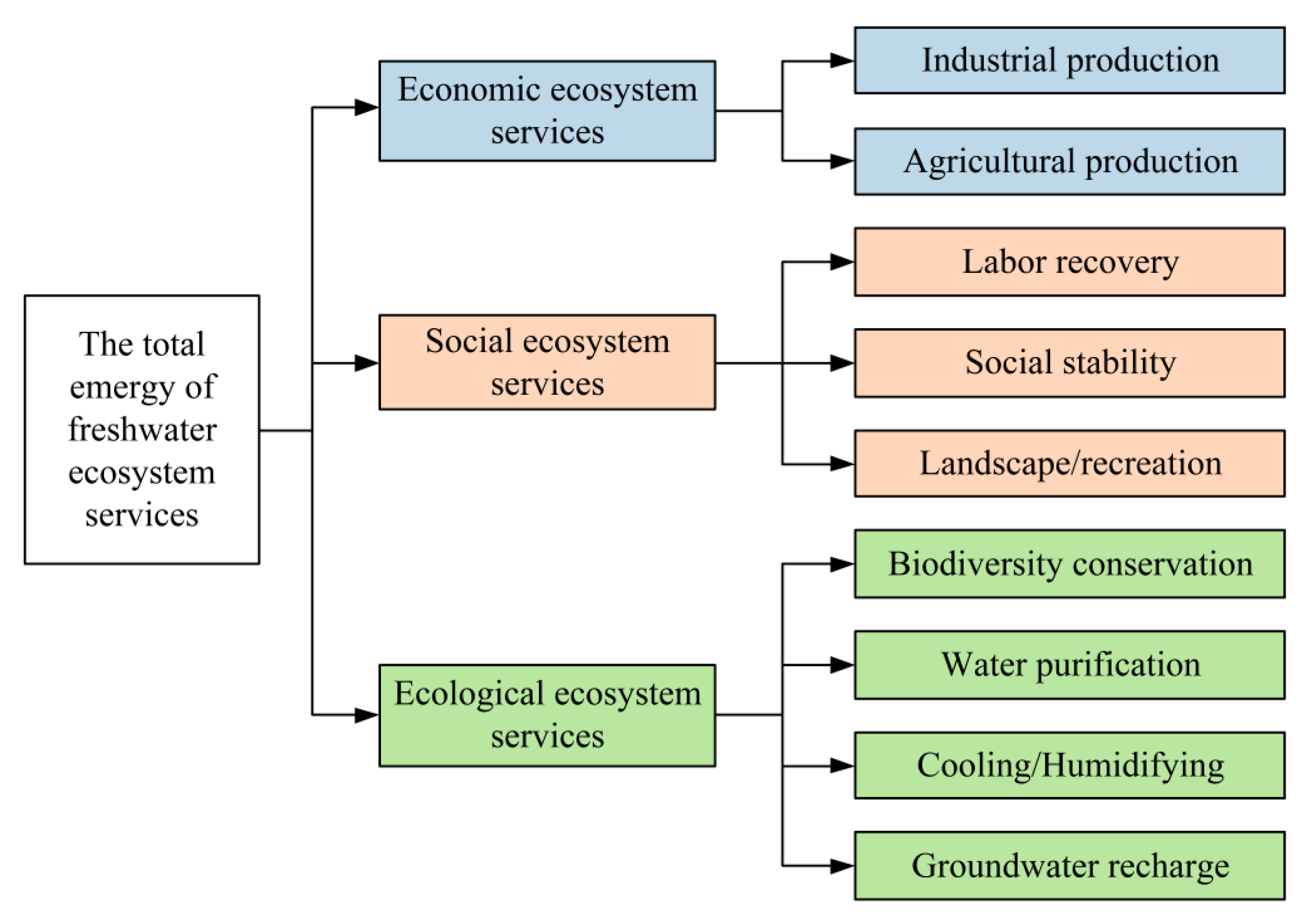
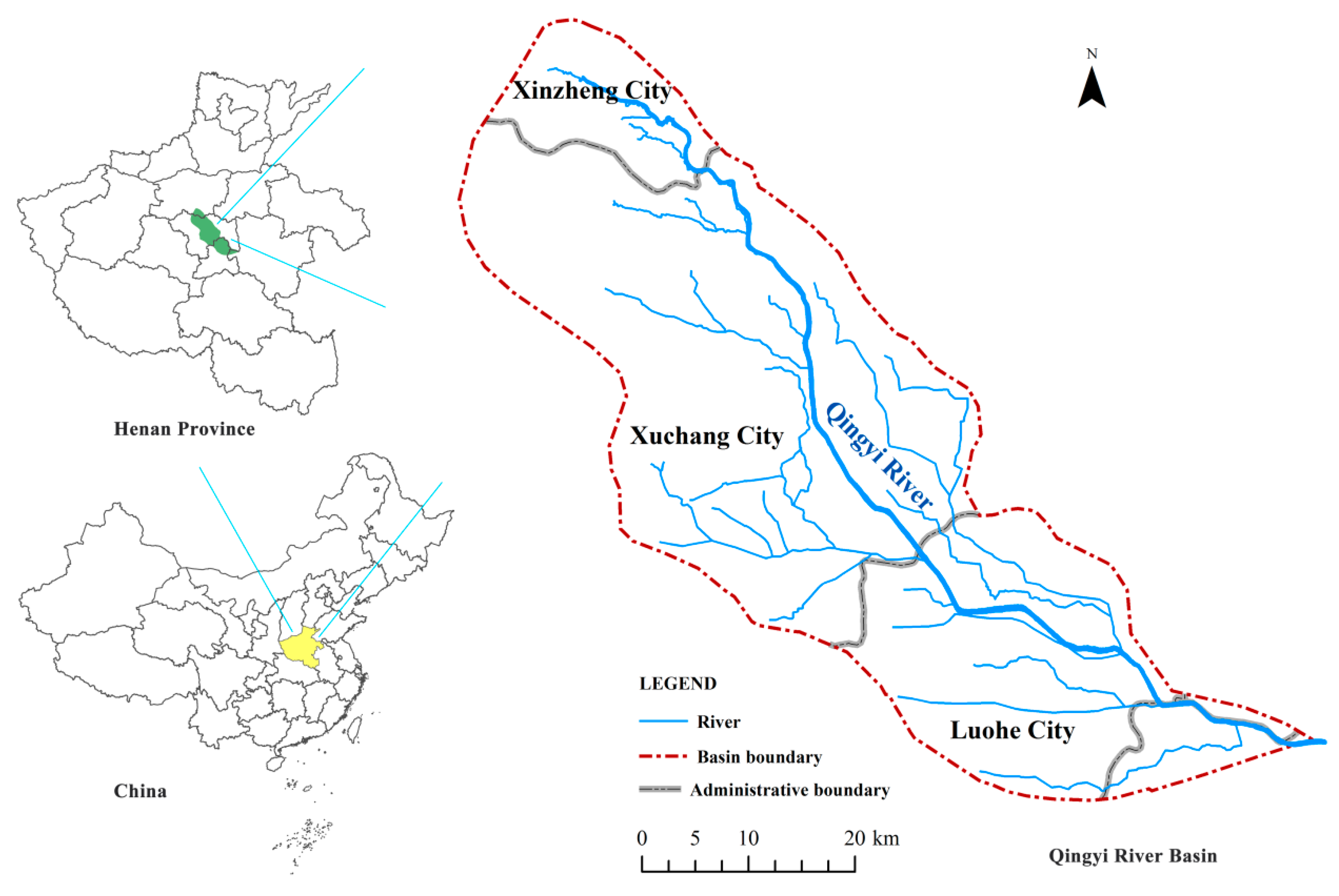
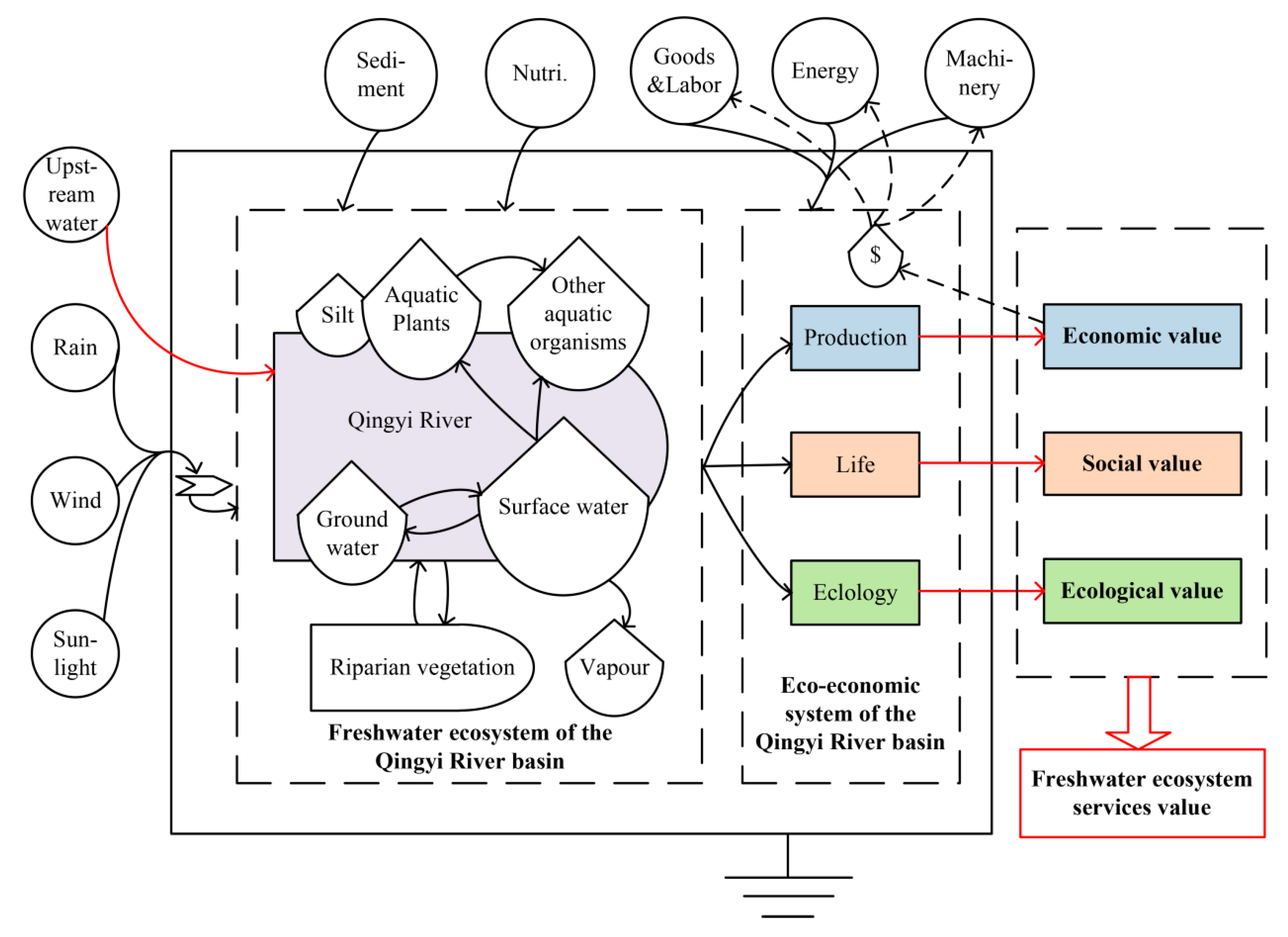
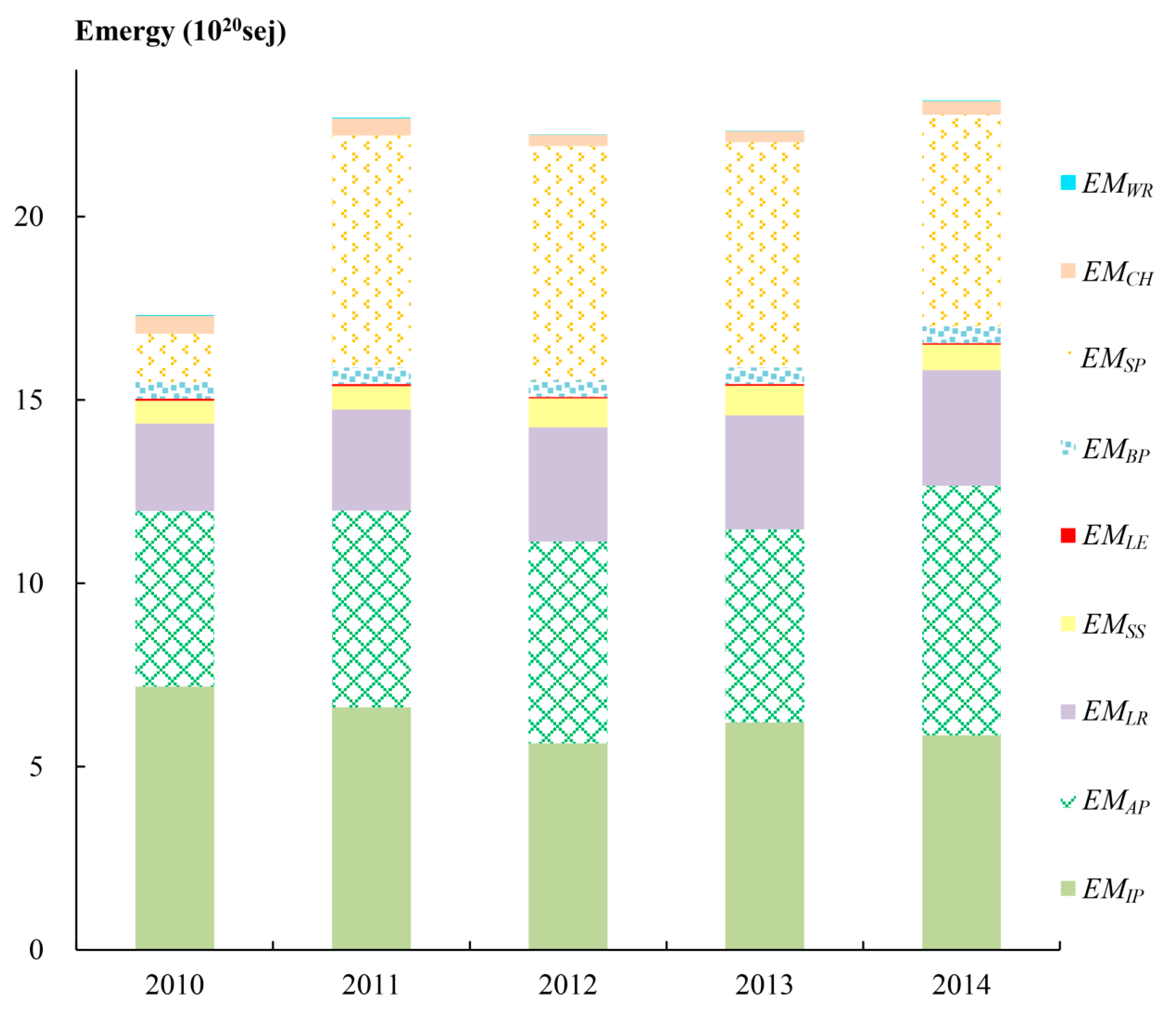
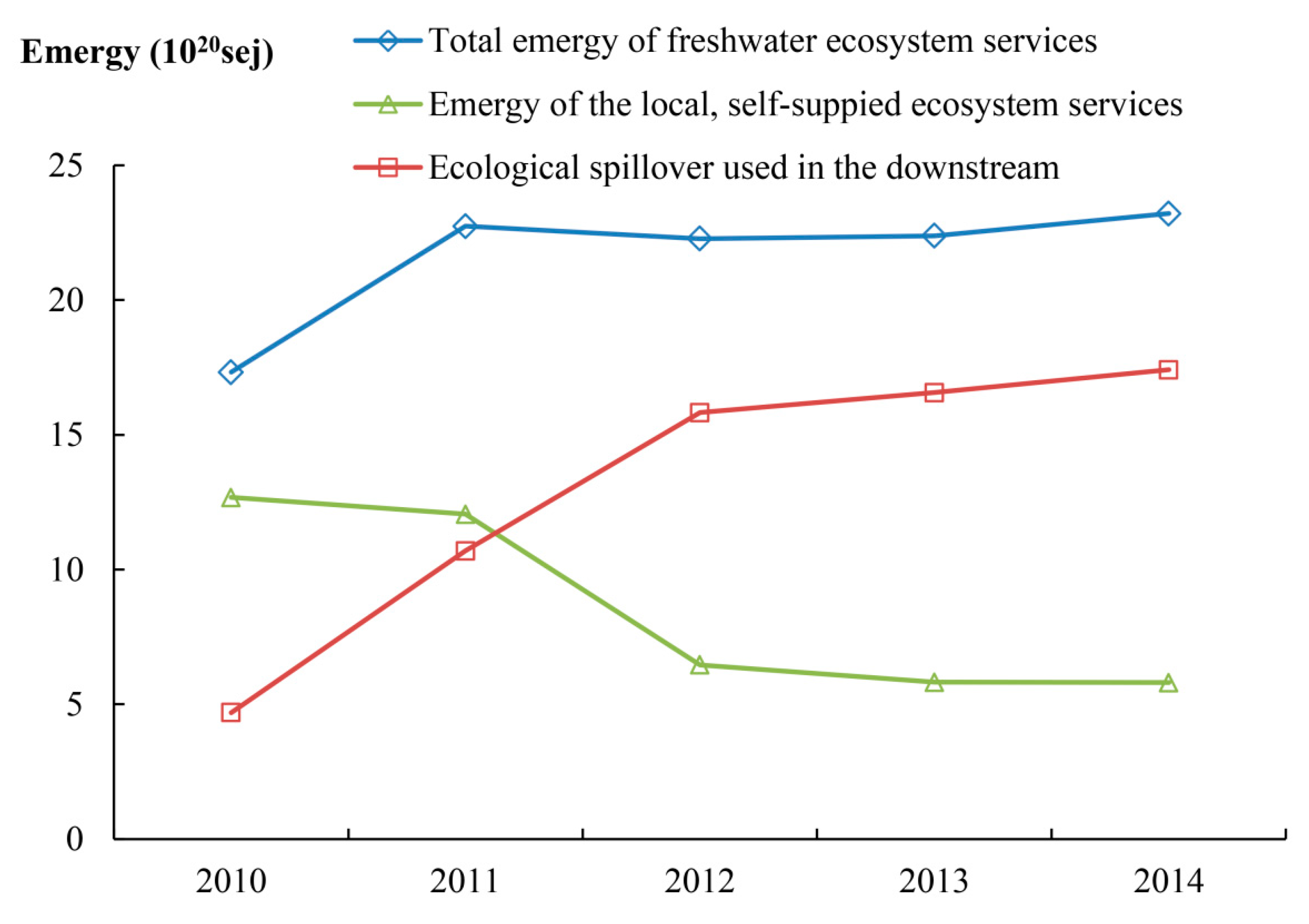
| Ecosystem Services | Service Types | Equation | Emergy (1020 sej) | ||||
|---|---|---|---|---|---|---|---|
| 2010 | 2011 | 2012 | 2013 | 2014 | |||
| Economic | Water input industry | Equations (4) and (5) | 7.19 | 6.62 | 5.64 | 6.20 | 5.86 |
| Water input agriculture | Equations (6) and (7) | 4.78 | 5.36 | 5.50 | 5.27 | 6.80 | |
| Economic ecosystem services | Section 2.3.1 | 11.97 | 11.98 | 11.14 | 11.47 | 12.66 | |
| Social | Labor recovery | Equations (8) and (9) | 2.39 | 2.76 | 3.11 | 3.11 | 3.15 |
| Social stability | Equation (10) | 0.62 | 0.64 | 0.79 | 0.81 | 0.70 | |
| Landscape/recreation | Equation (11) | 0.05 | 0.05 | 0.04 | 0.04 | 0.04 | |
| Social ecosystem services | Section 2.3.2 | 3.06 | 3.45 | 3.94 | 3.96 | 3.89 | |
| Ecological | Biodiversity conservation | Equation (12) | 0.50 | 0.50 | 0.50 | 0.50 | 0.50 |
| Water purification | Equation (13) | 1.32 | 6.32 | 6.39 | 6.14 | 5.77 | |
| Air cooling/humidifying | Equations (14) and (15) | 0.49 | 0.47 | 0.30 | 0.30 | 0.37 | |
| Groundwater recharge | Equation (16) | 0.02 | 0.02 | 0.01 | 0.01 | 0.02 | |
| Ecological ecosystem services | Section 2.3.3 | 2.33 | 7.31 | 7.20 | 6.95 | 6.66 | |
| Eco-economic | Total emergy of freshwater ecosystem services | Equation (3) | 17.36 | 22.74 | 22.28 | 22.38 | 23.21 |
| Items | Equation | 2010 | 2011 | 2012 | 2013 | 2014 |
|---|---|---|---|---|---|---|
| Ecological water-footprint demand (hm2) | Equation (18) | 646,271 | 647,924 | 682,634 | 634,701 | 596,685 |
| Ecological water-footprint supply (hm2) | Equation (19) | 471,318 | 342,937 | 201,015 | 164,758 | 149,736 |
| The coefficient of self-supply capacity | Equation (17) | 0.73 | 0.53 | 0.29 | 0.26 | 0.25 |
| The local, self-supplied services (1020 sej) | Equation (17) | 12.67 | 12.05 | 6.46 | 5.82 | 5.80 |
| Emergy of cological spillover (1020 sej) | Equation (20) | 4.69 | 10.69 | 15.82 | 16.56 | 17.41 |
| Emergy/money ratio (1011 sej/¥) | Section 2.3 | 4.74 | 4.41 | 3.95 | 3.77 | 3.42 |
| Ecological compensation (109¥) | Equation (21) | 0.99 | 2.42 | 4.00 | 4.39 | 5.09 |
Publisher’s Note: MDPI stays neutral with regard to jurisdictional claims in published maps and institutional affiliations. |
© 2021 by the authors. Licensee MDPI, Basel, Switzerland. This article is an open access article distributed under the terms and conditions of the Creative Commons Attribution (CC BY) license (http://creativecommons.org/licenses/by/4.0/).
Share and Cite
Li, H.; Lv, C.; Ling, M.; Gu, C.; Li, Y.; Wu, Z.; Yan, D. Emergy Analysis and Ecological Spillover as Tools to Quantify Ecological Compensation in Xuchang City, Qingyi River Basin, China. Water 2021, 13, 414. https://doi.org/10.3390/w13040414
Li H, Lv C, Ling M, Gu C, Li Y, Wu Z, Yan D. Emergy Analysis and Ecological Spillover as Tools to Quantify Ecological Compensation in Xuchang City, Qingyi River Basin, China. Water. 2021; 13(4):414. https://doi.org/10.3390/w13040414
Chicago/Turabian StyleLi, Huiqin, Cuimei Lv, Minhua Ling, Changkuan Gu, Yang Li, Zening Wu, and Denghua Yan. 2021. "Emergy Analysis and Ecological Spillover as Tools to Quantify Ecological Compensation in Xuchang City, Qingyi River Basin, China" Water 13, no. 4: 414. https://doi.org/10.3390/w13040414





